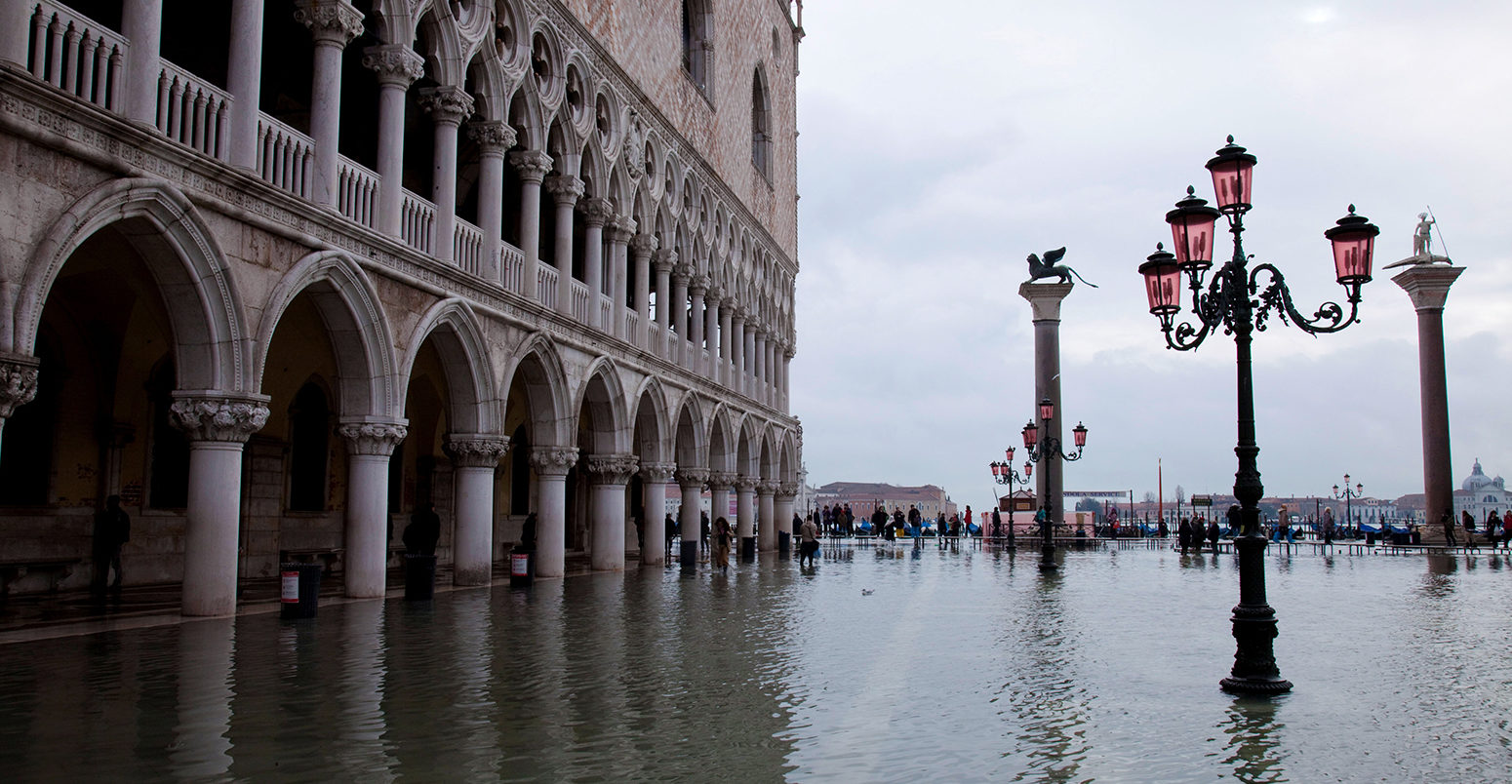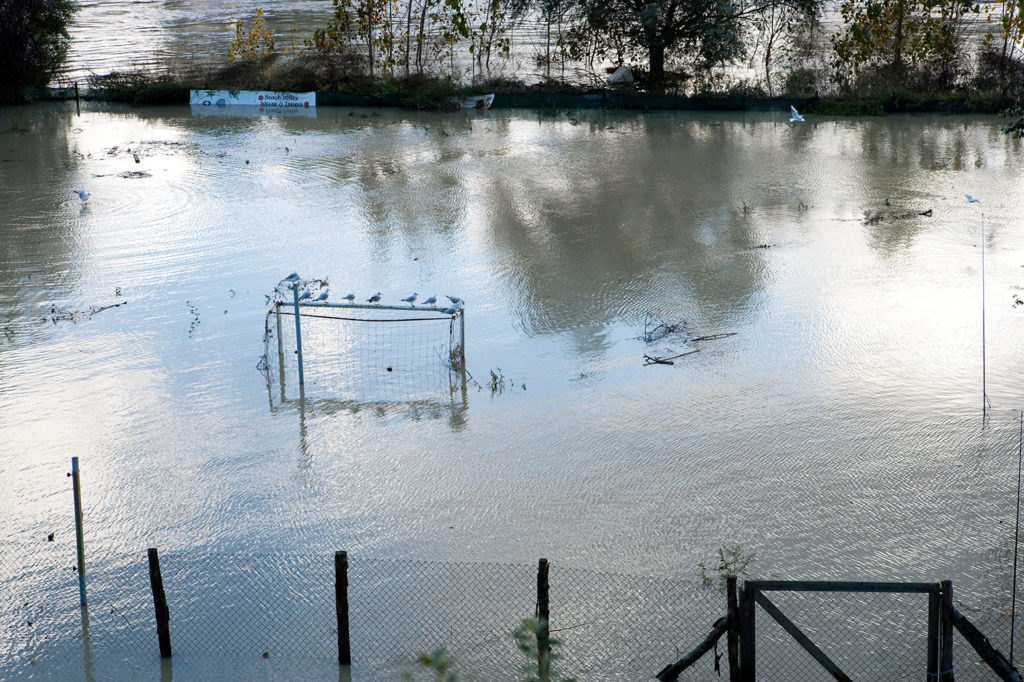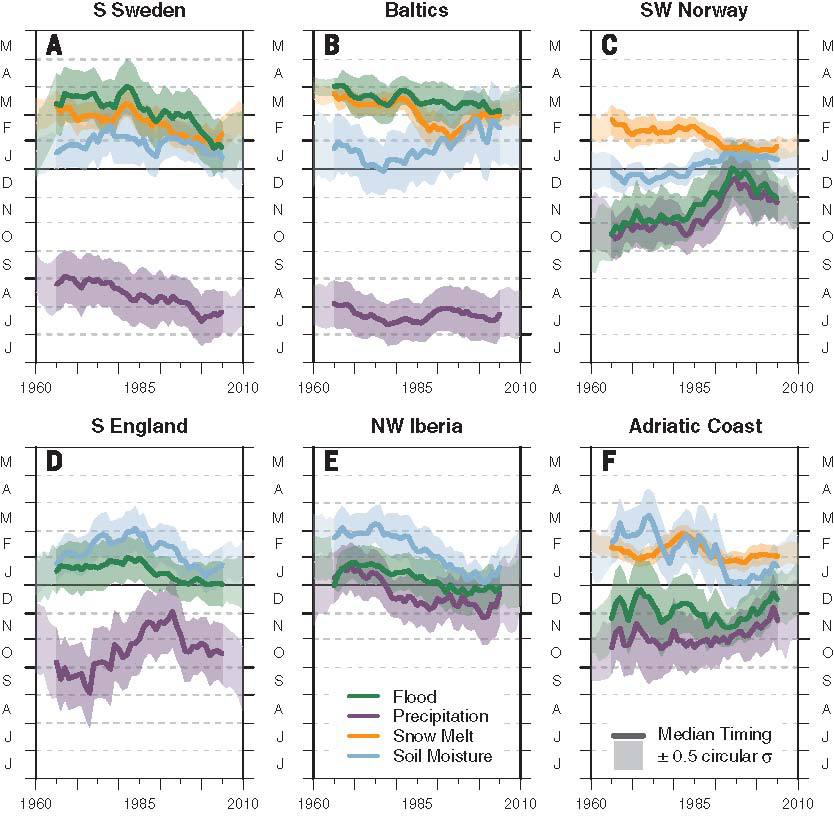
Climate change is already shifting the timing of European floods, study says
Daisy Dunne
08.10.17Daisy Dunne
10.08.2017 | 7:00pmClimate change is shifting the timing of river flooding across Europe, with parts of the continent experiencing flooding several weeks earlier or later than they did 50 years ago.
That is the conclusion of a new study, which uses data from more than 4,000 observational stations in 38 countries. The findings suggest that warming is driving earlier flooding in snowy parts of northeastern Europe and later floods in the west, including in southern England and Portugal.
The changes in flood timing pose risks for people and property, the researchers say, as well as animals that rely on floodplains for breeding.
However, there are some important caveats to the study, other scientists tell Carbon Brief, as natural climate variability also plays a “massive role” in the timing of European floods.

Football goalposts emerge from a flooded field close the river, near Ponte Milvio, Italy, 11/2010. Credit: CFimages / Alamy Stock Photo.
Europe’s changing landscape
Flooding from rivers affects more people worldwide than any other natural hazard, costing an average of $104bn (pdf) (£80bn) every year in damages, according to a report from the United Nations Office for Disaster Risk Reduction.
Such damages are expected to rise further in a warmer, wetter climate, which is expected to change the magnitude, frequency and timing of floods.
The new research, published in Science, is the first to paint a clear picture of how warming has affected the timing of flooding across Europe since 1960. The researchers used 50 years’ worth of data from 4,262 river gauging stations across Europe.
The map below illustrates their results. The red shaded areas indicate where floods are now arriving earlier than they did five decades ago, whereas blue shows where floods are occurring later in the year.

Map showing European regions that are experiencing flooding earlier (red) or later (blue) in days per decade (between 1960 and 2010). Numbered rings show regions with distinct climatic drivers (see text). Source: Blöschl et al. (2017)
The researchers picked out four regions where changes to flood timing have been driven by distinct climate-related changes.
In northeastern Europe (1), the timing of flooding has shifted from late March to February over the past five decades as winter snow melts earlier in spring, sending huge amounts of water into rivers.
This early snowmelt has been linked (pdf) to local temperature increases and warming-driven changes to Arctic air masses.
You can see this illustrated in the charts below, which show the timing of floods (green lines) as well as the peaks of each of their drivers – rainfall (purple), orange (snowmelt) and soil moisture (blue) – for six flooding “hotspots” in Europe.
In the Baltics, Sweden and Norway, the peak snowmelt has shifted to later in the year over the 50-year study period.

Charts showing the timing of floods (green) alongside the peaks in their main drivers – 7-day maximum rainfall (purple), peak snowmelt (orange) and maximum soil moisture (blue) – for six regions in Europe from 1960 to 2010. Note the y-axis has the calendar year running in reverse, from May (top) to June (bottom). Source: Blöschl et al. (2017)
In western Europe, causes of variability in flood time appear to be more complex.
In parts of the continent close to the North Sea (2), including Scotland, the majority of observational stations show a shift of more than eight days towards later flooding.
Winter floods in this part of Europe often follow in the wake of wet weather systems blown in from the North Atlantic.
The path of these storms is influenced by a natural fluctuation called the North Atlantic Oscillation (NAO), which brings large-scale changes in air pressure across the North Atlantic.
Changes to the NAO may be delaying the arrival of these storms over recent decades, meaning the heaviest rain arrives in December rather than October, the study says. These changes could be related to Arctic warming, although the role of human-induced climate change is still unconfirmed, the researchers note.
Close by in southern England (3), half of all recording stations show that flooding is now arriving eight days earlier than it did 50 years ago (see blue line in chart D above). This stark contrast can be explained by differences in soil types between Scotland and southern England, the researchers say.
Scottish soil tends to be shallow, while soil further south is deeper and can store larger amounts of rain before becoming saturated. The researchers believe that a swing towards wetter autumn months – which has been influenced by climate change – has caused the point of saturation to occur earlier in the year over the past five decades.
Consequences
Changes to the timing of flooding across Europe could have far-reaching consequences for both people and wildlife, the researchers say.
Shifts in timing could lead to more intense flooding in some parts of continent, which could put both people and property at risk.
Earlier or later flooding may affect industries that make use of water from rivers, says Dr Louise Slater, a lecturer in physical geography at Loughborough University, who co-authored an accompanying News & Views article about the study. She tells Carbon Brief:
“Sectors such as hydropower production, infrastructure operation, or water management [reservoirs] will be directly affected. There could also be indirect consequences for other sectors that are affected by changes in seasonality, such as agriculture.”
In addition, changes to the arrival time of floods could disrupt the breeding behaviour of fish that lay their eggs in submerged flood plains, says Prof Günter Blöschl, lead author of the new research and director of the Centre for Water Resource Systems at the Vienna University of Technology. He tells Carbon Brief:
“These are animals that have spent hundreds, if not thousands of years, evolving to line up their spawning [egg-laying] behaviour with the times that floodplains fill with water.”
Finding a climate signal
The results are a clear sign that climate change is already affecting flooding dynamics in Europe, says Blöschl:
“Our analysis is comprehensive enough to allow us to say: ‘Yes, the impacts of climate change on flooding are real and they are happening now.’ But climate change has affected the seasonality [timing] of flooding in different ways depending on where you look in Europe.”
Focusing the study on “flood seasonality” – the timing of floods – rather than more traditional measures, such as flood magnitude of frequency, is a more sensitive metric for detecting climate signals in flooding patterns, says Slater:
“There are many different factors that affect flood magnitude and frequency at the same time: atmospheric changes (such as precipitation and temperature) and land cover (such as urbanisation and agriculture). Therefore, when we detect a change, we cannot really say whether the change is related to climate. By measuring the seasonal timing of floods, it is much more likely that any detected changes are due to climate.”
However, although the researchers were able to eliminate the influence of drivers that are unrelated to climate change, they do not necessarily differentiate between human-induced warming and naturally occurring climate variability, says Prof Peter Stott, acting director of Met Office Hadley Centre and professor of detection and attribution of climate change, who was not involved in the research. He tells Carbon Brief:
“The massive role of climate variability is heavily glossed over. They don’t, as far as I can see, evaluate how these signals compare with possible natural variations so I don’t see this as convincing evidence of a clear climate signal.”
For example, says Stott, even with a trend towards earlier flooding in southern England, this does not mean that over the next few years we’re going to see floods earlier in winter. When winter floods occur, they will be dominated by natural variability, he says. That is not to say there isn’t a climate change impact, he adds:
“I suspect, though, by averaging up large amounts of data in this way, they are seeing some hints of the expected climate signal.”
Another caveat is that the study is looking at data on peak annual river flows, which do not necessarily translate into floods, says Dr Lorenzo Alfieri, from the European Commission’s Joint Research Centre, who also was not involved in the research, but authored an earlier study on flood damages in Europe. He tells Carbon Brief:
“Although the term ‘floods’ is used consistently throughout the text, this is in reality the series of annual discharge peaks, hence the vast majority of events do not correspond to a flood in that they probably didn’t exceed the local flood protection level.”
Blöschl, G. et al. (2017) Changing climate shifts timing of European floods, Science, doi/10.1126/science.aan2506
Slater, L. J. and Wilby, R. L. (2017) Measuring the changing pulse of rivers, Science, doi:10.1126/science.aao2441
-
Climate change is already shifting the timing of European floods, study says

